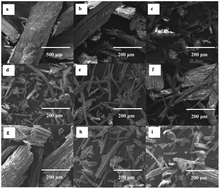Low temperature pretreatment of sugarcane bagasse at atmospheric pressure using mixtures of ethylene carbonate and ethylene glycol†
Abstract
A low temperature lignocellulose pretreatment process was developed using acid-catalysed mixtures of alkylene carbonate and alkylene glycol. Pretreatment of sugarcane bagasse with mixtures of ethylene carbonate (EC) and


 Please wait while we load your content...
Please wait while we load your content...